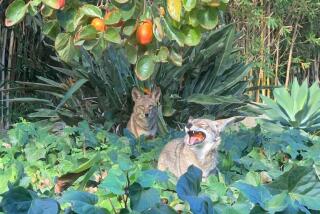Snake in the Class : Ventura: Youngsters learn about slithery reptiles in preparation for the annual springtime encounters.
- Share via
Until her close encounter Thursday, Ashlee Dana considered snakes icky, slimy creatures the boys used to torment her. But petting a four-foot California gopher snake was all it took to change her mind.
“I like ‘em and I want to get one,” said the 9-year-old, sitting on the lawn in front of Blanche Reynolds Elementary School in Ventura, where she and 30 of her second- through fourth-grade classmates handled nonpoisonous snakes and learned some do’s and don’ts of dealing with the coldblooded critters.
Patrick Musone, community education officer for the Ventura County Animal Regulation Department, brought the reptiles to Jan Cornell-Brovold’s class to teach the pupils how to tell venomous from harmless snakes. The class is one of several offered to children and adults in preparation for the annual spring increase in run-ins with the slithering beasts in hills, fields and back yards across Ventura County.
“It is important for children and adults to be able to recognize the indigenous species in Ventura County and to be able to respond to encounters in thoughtful, safe and ecologically sensitive ways,” Musone said.
For the past two years, Musone has been giving snake presentations to homeowners groups, park rangers and schoolchildren in an attempt to prevent the needless killing of snakes, which help control the rodent population.
“We do have a lot of snakes in the county,” Musone said. “People need to recognize them by their morphology, or their physical characteristics” to prevent needless shovel-whacking and beheading of the creatures.
After handling the snake, Ashlee wrinkled her nose at the thought of bringing one home to meet her family. “They’ll scream,” she said. “My mom especially.”
Another pupil admitted to residual fears even after the snake show.
“I don’t know if I’d want to hold one,” said Ashlee’s friend, Chelsea Rasmussen. “Maybe when I’m not as scared.”
Before the presentation, 9-year-old Chelsea said, “I thought they were really gross. I thought they were slimy and I thought they would bite.”
She added, however, “If I see one, I’m just going to keep on walking.”
Cornell-Brovold, an avid hiker in Matilija Canyon above Ojai, said the presentation was a St. Patrick’s Day class project about the Irish folk tale that had the saint chasing off snakes with a drum.
“We tried it in the class with one of the student’s snakes and it didn’t work,” Cornell-Brovold said.
Throughout the presentation, Musone injected figures and facts.
The only venomous snake in California is the southern Pacific rattler, he said, and “50% of the time they strike, they don’t inject venom. More people are killed by lightning strikes than by snakebites.”
Musone said his mission includes dispelling the myths about first aid for snakebites.
“You don’t use ice,” Musone said. “You don’t use a tourniquet and you don’t cut the skin.” You should, however, move the victim away to prevent more bites, wash the wound, quiet the victim to slow blood circulation and transport him or her to a medical facility.
Another animal regulation official said calls of sightings have been few this year, but that will soon change.
“We’ve only had three calls since January,” said Kathy Jenks, the department’s director. “It’s way early. By the end of August, we’ll have had hundreds.”
Jenks said the winter cold and dampness keep snakes in hiding until March or April. When they come out, they’ll be most prevalent in the foothills near Moorpark, Simi Valley and the Ojai Valley area. “They’re just coming out of their winter hibernation,” Jenks said.
Musone admitted he hasn’t always been brave about snakes.
He recalled cooling off at his favorite swimming hole in Easton, Conn., where he grew up. Ready to plunge into the water one hot summer afternoon, he spotted a giant water snake and fairly panicked.
But since then, he has developed quite a sensitivity for the reptiles.
“Most negative encounters happen because of ignorance,” Musone said. And with a satisfied smile, he said of his attentive listeners Thursday:
“Knowledge will hold them in good stead.”
More to Read
Sign up for Essential California
The most important California stories and recommendations in your inbox every morning.
You may occasionally receive promotional content from the Los Angeles Times.













